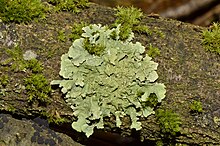Flavoparmelia
| Flavoparmelia | |
|---|---|

| |
| Flavoparmelia caperata | |
| Scientific classification | |
| Domain: | Eukaryota |
| Kingdom: | Fungi |
| Division: | Ascomycota |
| Class: | Lecanoromycetes |
| Order: | Lecanorales |
| Family: | Parmeliaceae |
| Genus: | Flavoparmelia Hale (1986) |
| Type species | |
| Flavoparmelia caperata (L.) Hale (1986)
| |
Flavoparmelia is a genus of foliose lichens in the family Parmeliaceae. Because of their appearance, they are commonly known as greenshield lichens.[1] The widely distributed genus contains 32 species.[2] It was circumscribed by American lichenologist Mason Hale in 1986 to contain 17 former Pseudoparmelia species with broad lobes, usnic acid in the cortex, and isolichenan in the cell walls.[3]
Description[edit]
Flavoparmelia lichens are medium sized foliose lichens that are yellow-green in colour, with a thallus comprising rounded lobed that measure 2–8 mm wide, which form flat and loosely attached patches that are 6–20 cm (2.4–7.9 in) wide. Older parts of the upper thallus surface are wrinkled, while the newer parts are smooth. There is a black lower surface with simple, unbranched rhizines, and a distinct bare zone around the margin. The photobiont partner is green algae from genus Trebouxia.[1] Flavoparmelia has larger spores than other segregate genera of Pseudoparmelia.
Biogeography[edit]
The distributional ranges of Flavoparmelia species have been shaped by both long-distance dispersal and vicariance. A 2013 study identified more geographical structure within Flavoparmelia than previously recognized, with some species having wider distributions than others. The authors suggest that phenotypical species delimitation often underestimates true diversity. Flavoparmelia originated in southern South America, and its major radiation began in the late Oligocene. The splits in the genus occurred at different times, shaping the diversity of the main lineages within the genus. The South American ancestor of Flavoparmelia originated before the separation of southern South America and Australia from Antarctica, suggesting that vicariance could have played a role in shaping this distribution. Recent diversification in Australia resulted from recent diversification at the Miocene-Pliocene boundary. Group 3 (a cluster of Flavoparmelia species that have wider distributions, such as the subcosmopolitan F. soredians) is estimated to have originated in the Cape Region of South Africa during the late Miocene. Long-distance dispersal can account for the current distribution of some species, while evidence for vicariance has also been shown in Parmeliaceae.[4]
Species[edit]


- Flavoparmelia baltimorensis (Gyeln. & Fóriss) Hale (1986)
- Flavoparmelia caperata (L.) Hale (1986)
- Flavoparmelia caperatula (Nyl.) Elix, O.Blanco & A.Crespo (2010)
- Flavoparmelia citrinescens (Gyeln.) O.Blanco, A.Crespo & Elix (2010)
- Flavoparmelia diffractaica Elix & J.Johnst. (1988)[5]
- Flavoparmelia ecuadorensis T.H.Nash, Elix & J.Johnst. (1987)
- Flavoparmelia euplecta (Stirt.) Hale (1986)
- Flavoparmelia ferax (Müll.Arg.) Hale (1986)
- Flavoparmelia haysomii (C.W.Dodge) Hale (1986)
- Flavoparmelia haywardiana Elix & J.Johnst. (1988)[5]
- Flavoparmelia helmsii (Kurok. & Filson) Hale (1986)
- Flavoparmelia kantvilasii Elix (1993)[6] – New South Wales
- Flavoparmelia marchantii Elix, O.Blanco & A.Crespo (2005)[7] – Australia
- Flavoparmelia norfolkensis Elix & Streimann (1989)[8] – Norfolk Island
- Flavoparmelia plicata Aptroot & M.Cáceres (2014)[9] – Brazil
- Flavoparmelia proeuplecta Elix & J.Johnst. (1988)[5]
- Flavoparmelia rutidota (Hook.f. & Taylor) Hale (1986)
- Flavoparmelia scabrosina Elix & J.Johnst. (1988)[5]
- Flavoparmelia secalonica Elix & J.Johnst. (1988)[5]
- Flavoparmelia soredians (Nyl.) Hale (1986)
- Flavoparmelia springtonensis (Elix) Hale (1986)
- Flavoparmelia subambigua (Hale) O.Blanco, A.Crespo & Elix (2010)
- Flavoparmelia succinprotocetrarica Elix & J.Johnst. (1988)[5]
- Flavoparmelia virensica Elix, O.Blanco & A.Crespo (2010)
References[edit]
- ^ a b Brodo, Irwin M.; Sharnoff, Sylvia Duran; Sharnoff, Stephen (2001). Lichens of North America. Yale University Press. p. 316. ISBN 978-0300082494.
- ^ Wijayawardene, Nalin; Hyde, Kevin; LKT, Al-Ani; S, Dolatabadi; Stadler, Marc; Haelewaters, Danny; Tsurykau, Andrei; Mesic, Armin; Navathe, Sudhir; Papp, Viktor; Oliveira Fiuza, Patrícia; Vázquez, Víctor; Gautam, Ajay; Becerra, Alejandra G.; Ekanayaka, Anusha; K. C., Rajeshkumar; Bezerra, Jadson; Matočec, Neven; Maharachchikumbura, Sajeewa; Suetrong, Satinee (2020). "Outline of Fungi and fungus-like taxa". Mycosphere. 11: 1060–1456. doi:10.5943/mycosphere/11/1/8. hdl:10481/61998.
- ^ Hale, M.E. 1986. "Flavoparmelia, a new genus in the lichen family Parmeliaceae (Ascomycotina)". Mycotaxon. 25 (2): 603–605.
{{cite journal}}: CS1 maint: numeric names: authors list (link) - ^ Del-Prado, Ruth; Blanco, Oscar; Lumbsch, H. Thorsten; Divakar, Pradeep K.; Elix, John. A.; Molina, M. Carmen; Crespo, Ana (2013). "Molecular phylogeny and historical biogeography of the lichen-forming fungal genus Flavoparmelia (Ascomycota: Parmeliaceae)". Taxon. 62 (5): 928–939. doi:10.12705/625.22.
- ^ a b c d e f Elix, John A.; Johnston, Jen (1988). "New species and new reports of Flavoparmelia (lichenized Ascomycotina) from the Southern Hemisphere". Mycotaxon. 33: 391–400.
- ^ Elix, John A. (1993). "New species in the lichen family Parmeliaceae (Ascomycotina) from Australia". Mycotaxon. 47: 101–129.
- ^ Elix, John A.; Blanco, Oscar; Crespo, Ana (2005). "A new species of Flavoparmelia (Parmeliaceae, lichenized Ascomycota) from Western Australia" (PDF). Australasian Lichenology. 56: 12–15.
- ^ Elix, John A.; Streimann, Heinar (1989). "The lichens of Norfolk Island 1: Introduction and the family Parmeliaceae". Proceedings of the Linnean Society of New South Wales. 111 (2): 103–122.
- ^ Aptroot, André; Cáceres, Marcela Eugenia da Silva (2014). "A key to the corticolous microfoliose, foliose and related crustose lichens from Rondônia, Brazil, with the description of four new species". Lichenologist. 46 (6): 783–799. doi:10.1017/S0024282914000358. S2CID 83968727.
